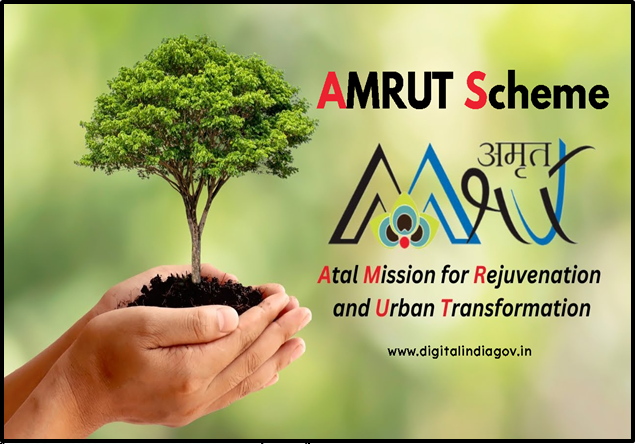AN OVERVIEW OF THE AMRUT SCHEME
Syllabus:
GS-2:
Government Policies and Interventions for Development in various sectors
Why in the news?
- Analysis of the Atal Mission for Rejuvenation and Urban Transformation (AMRUT) scheme.
- Highlights its purpose, progress, challenges, shortcomings, and recommendations for improvement in urban infrastructure development.
source:digitalindia
Focus:
- AMRUT scheme highlighted for its progress in urban infrastructure development.
- Challenges include limited participation, inadequate water management, and fragmented implementation.
- Recommendations emphasize holistic approaches and community involvement.
- News coverage reflects ongoing efforts to address urban development challenges.
| About AMRUT Mitra initiative:
Objective:
Implementation:
Goal:
Anticipated Outcomes:
What is Atal Mission for Rejuvenation and Urban Transformation(AMRUT) Scheme?
Introduction of AMRUT 2.0:
Promotion of Circular Economy of Water:
Components of AMRUT 2.0:
Financial Outlay:
Significance of AMRUT 2.0:
About Pey Jal Survekshan Awards :
Parameters and Grading:
Survey Methodology:
About IEC Campaign Against Malnutrition:
Objectives:
|
Understanding the AMRUT Scheme:
- Purpose of the AMRUT Scheme:
- Ensure access to tap water and sewerage connections for every household.
- Enhance city value through greenery and well-maintained open spaces.
- Reduce pollution by promoting public transport and non-motorised transport facilities.
- Scheme Description:
- Launched by the NDA-1 government in June 2015, with a 2.0 version introduced in October 2021.
- A flagship program aimed at addressing challenges in water, mobility, and pollution infrastructure in urban areas.
- Intended to cover 500 cities and towns with populations over one lakh and notified municipalities.
- Total outlay for AMRUT was ₹50,000 crore for five years from FY 2015-16 to FY 2019-20.
- AMRUT 2.0 Goals:
- Aimed at making cities water secure and providing functional water tap connections to all households in statutory towns.
- Set ambitious targets, including 100% sewage management in 500 AMRUT cities.
- Total outlay for AMRUT 2.0 is ₹2,99,000 crore, with ₹76,760 crore allocated by the central government for five years.
- Progress of the Scheme:
- As of May 19, 2024, ₹83,357 crore has been dispersed.
- Utilized funds provided 58,66,237 tap connections and 37,49,467 sewerage connections.
- 2,411 parks have been developed, and 62,78,571 LED lights have been replaced.
- Contributions made by States and cities also factor into these achievements.
- Challenges and Shortcomings:
- Lack of holistic approach, focusing more on project-oriented initiatives.
- Limited participation from cities, with the scheme predominantly managed by bureaucrats, parastatals, and large technology-based companies.
- Water management issues are inadequately addressed, leading to insufficient sewage treatment and infrastructure problems.
- Disconnection between urban planning and real estate development, resulting in the disappearance of water bodies and disrupted stormwater flows.
- Need for nature-based solutions and a people-centric approach, emphasizing the empowerment of local bodies.
- Reality Check:
- Despite scheme implementation, significant challenges persist, with millions lacking access to adequate water and sanitation facilities.
- Inadequate water, sanitation, and hygiene contribute to approximately 2,00,000 deaths annually.
- Disease burden due to unsafe water and sanitation remains significantly higher in India compared to other countries like China.
Insights into AMRUT Scheme Progress and Challenges:
Achievements:
- Since its inception, the AMRUT scheme has facilitated significant advancements in urban infrastructure across India.
- Provision of tap water and sewerage connections to millions of households has improved living standards and public health.
- Development of parks and open spaces has enhanced the aesthetic appeal of cities and provided recreational areas for residents.
- Replacement of conventional lights with LED lights has contributed to energy efficiency and reduced carbon emissions.
- The scheme’s financial assistance has catalyzed urban development projects and encouraged collaboration between the central government, states, and municipalities.
Challenges and Shortcomings:
- Despite notable progress, the AMRUT scheme faces several challenges that hinder its effectiveness.
- The lack of a holistic approach has resulted in a fragmented implementation process, with a focus on individual projects rather than comprehensive urban rejuvenation.
- Limited participation from local governments and communities has led to governance issues and reduced ownership of projects at the grassroots level.
- Inadequate attention to water management has resulted in insufficient sewage treatment infrastructure and environmental degradation in urban areas.
- The disconnect between urban planning and real estate development has led to the unchecked expansion of cities, causing ecological imbalances and loss of natural resources.
- The reliance on private interests and bureaucratic structures has marginalized the involvement of elected representatives and local stakeholders in decision-making processes.
Recommendations for Improvement:
- Adopt a holistic and integrated approach to urban rejuvenation, focusing on sustainable development goals and community empowerment.
- Strengthen the involvement of local governments and communities in project planning, implementation, and monitoring to ensure transparency and accountability.
- Prioritize nature-based solutions and green infrastructure to address water management challenges and mitigate the impact of climate change on urban areas.
- Promote inclusive and participatory urban planning processes that prioritize the needs and aspirations of all stakeholders, including marginalized communities.
- Enhance coordination and cooperation between government agencies, private sector entities, and civil society organizations to leverage resources and expertise for effective urban transformation.
Conclusion:
The AMRUT scheme represents a significant initiative towards rejuvenating and transforming urban India. While it has achieved notable successes in improving access to essential services and enhancing urban infrastructure, critical challenges and shortcomings remain. Addressing these issues requires a concerted effort from all stakeholders, with a focus on holistic and participatory approaches to urban development. By embracing sustainable and inclusive practices, the AMRUT scheme can contribute to creating vibrant, resilient, and livable cities for all citizens.
Mains Practice Question:
Discuss the Atal Mission for Rejuvenation and Urban Transformation (AMRUT) scheme in India, highlighting its objectives, financial allocation, progress, shortcomings, and recommendations for improvement. Evaluate the scheme’s impact on urban infrastructure development and address the challenges hindering its effectiveness.




